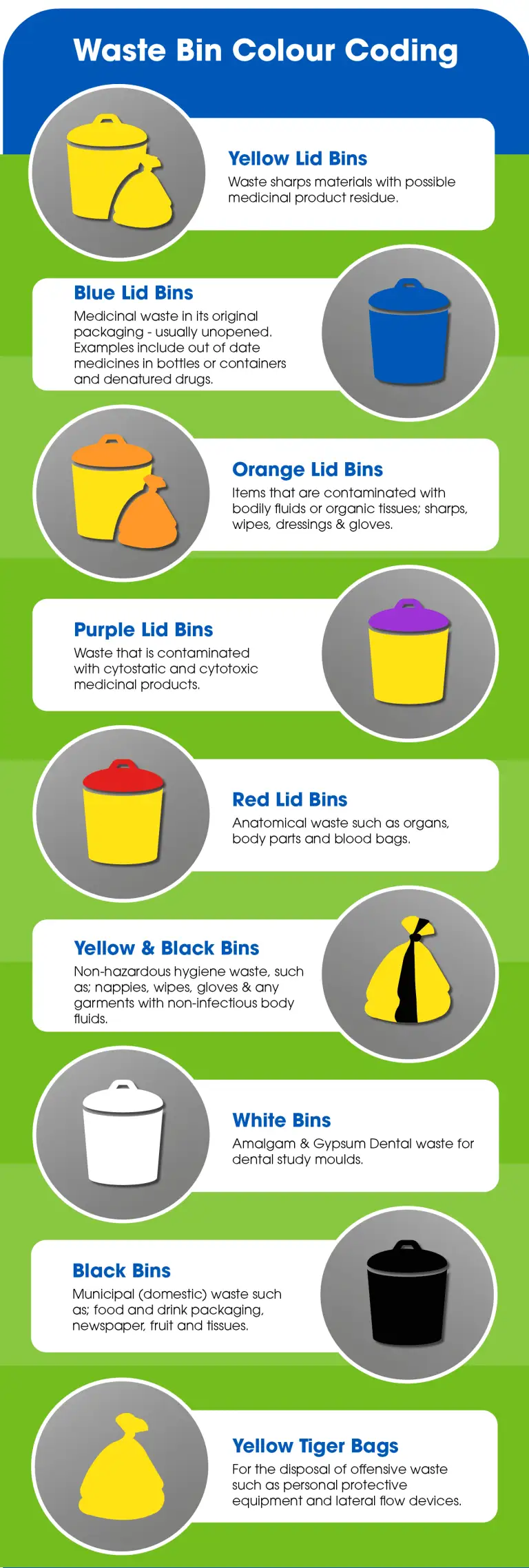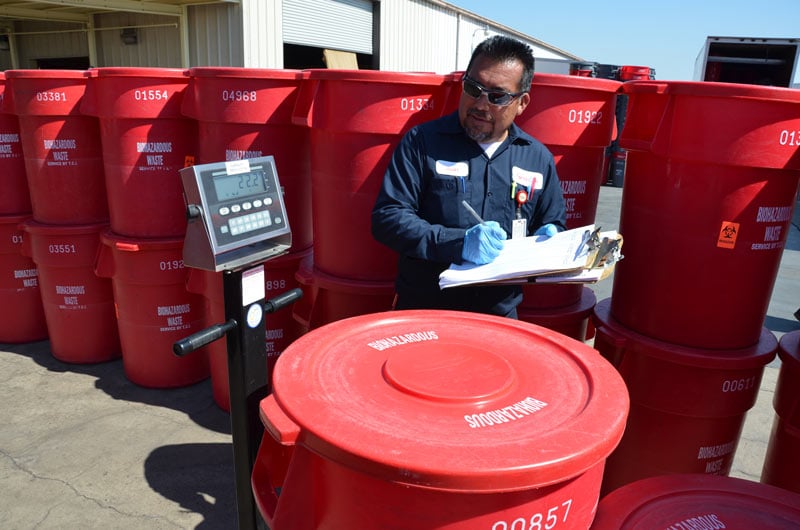Conformity and Regulations for Medical Waste Disposal
Compliance and guidelines for medical garbage disposal play a vital role in making certain the security and health of both health care professionals and the basic public. Appropriate monitoring of medical waste is necessary to stop the spread of infections, protect the atmosphere, and maintain public health and wellness. This calls for adherence to certain guidelines and procedures stated by regulatory companies and bodies. These regulations include numerous aspects, including the category and segregation of medical waste, correct storage and managing treatments, as well as transportation and disposal techniques. By adhering to these policies, health care centers can minimize the danger of contamination and possible injury to individuals and the atmosphere. This post will certainly explore the importance of conformity and give an overview of the essential guidelines controling clinical garbage disposal.
Relevance of Compliance
The importance of compliance with regulations for medical waste disposal can not be overemphasized. Correct disposal of clinical waste is vital for ensuring the security and wellness of healthcare workers, people, and the basic public. Clinical waste, which includes items such as made use of needles, infected gloves, and biomedical waste, can position serious health threats if not dealt with and dealt with properly.
Conformity with guidelines guarantees that clinical waste is managed in such a way that decreases the capacity for direct exposure to dangerous materials and contagious diseases - medical waste removal service. It aids stop the spread of infections, such as HIV, hepatitis B and C, and various other bloodborne virus. Compliance additionally plays a crucial role in securing the atmosphere by protecting against contamination of water sources, dirt, and air
Failure to abide with laws can lead to extreme repercussions for medical care facilities, consisting of penalties, legal activity, and damages to their online reputation. Furthermore, non-compliance might compromise the health and wellness of healthcare employees, patients, and the neighborhood.
Conformity with regulations for medical garbage disposal requires adherence to particular standards and protocols. These may consist of correct segregation, packaging, labeling, and storage space of clinical waste. It additionally entails making use of approved disposal techniques, such as incineration, autoclaving, or landfilling, depending upon the kind of waste.
Regulative Agencies and Bodies
Governing firms and bodies play an important function in looking after conformity with regulations for medical waste disposal. These organizations are in charge of establishing protocols, guidelines, and standards to make certain the correct and secure handling of medical waste. They implement and keep an eye on compliance to safeguard public health and the environment.
Among one of the most famous regulative firms in the USA is the Environmental Security Agency (EPA) The EPA is in charge of regulating the storage, transportation, therapy, and disposal of clinical waste. They develop guidelines for waste generators, transporters, and therapy centers to comply with, guaranteeing that all necessary precautions are required to avoid the spread of diseases and contamination.
Another vital regulative body is the Occupational Safety and Wellness Management (OSHA) OSHA sets criteria and guidelines to secure workers from occupational threats, including those relevant to clinical waste. WasteX Medical Waste Disposal. They give standards for the risk-free handling and disposal of clinical waste to safeguard staff members in healthcare centers
Along with these federal firms, individual states additionally have their own regulatory bodies that look after medical waste disposal. These firms may have their own certain regulations and demands that have to be followed.

Classification and Partition of Clinical Waste
To guarantee correct management of medical waste, it is hop over to here important to classify and segregate it according to developed standards and methods. medical waste disposal. Classification and partition play a crucial function in lessening the threat of infection, protecting the environment, and ensuring the safety and security of medical care employees and the general public
Medical waste is categorized right into various groups based upon its possible danger level. These categories include infectious waste, pathological waste, sharps waste, pharmaceutical waste, chemical waste, and radioactive waste. Each classification needs certain handling, disposal, storage space, and transport techniques to reduce the risk of exposure and contamination.
Segregation of clinical waste involves separating various kinds of waste at the resource. This procedure makes sure that waste with various danger levels is not mixed, decreasing the potential for cross-contamination and making disposal procedures more efficient. Proper partition is attained with the use of color-coded labels and containers, which aid medical care workers and waste administration personnel identify and take care of each type of waste appropriately.
Along with category and segregation, medical care centers must additionally stick to neighborhood, state, and federal laws concerning clinical waste monitoring. These laws outline particular demands for storage space, transportation, treatment, and final disposal of clinical waste, guaranteeing compliance and keeping public wellness and security.
Correct Storage and Handling Treatments
Correct storage space and managing treatments play an important function in ensuring the compliant and secure administration of medical waste. Clinical waste, which includes things such as utilized syringes, polluted gloves, and ran out medications, can posture severe health and ecological dangers otherwise managed correctly. It is critical for health care centers and other generators of medical waste to apply stringent storage space and dealing with methods.
To begin with, clinical waste should be kept in sturdy, leak-proof containers that are especially designed for this function. These containers need to be identified with the global biohazard symbol and the words "clinical waste" to plainly indicate the components. In addition, the containers should be kept firmly shut to avoid any type of possible leakage or splilling.
In addition, it is important to segregate various sorts of clinical waste to prevent cross-contamination. Sharps, such as scalpels and needles, ought to be saved in puncture-resistant containers to lessen the risk of injuries - WasteX Medical Waste Disposal. Chemical waste, such as solvents and anti-bacterials, need to be saved independently from various other kinds of clinical waste to protect against chain reactions or hazardous direct exposures

Transport and Disposal Techniques
Health care facilities must make certain the risk-free transportation and correct disposal of their clinical waste to abide by regulations and shield public health and wellness. Transportation and disposal approaches play a crucial duty in stopping the spread of contagious diseases and decreasing the environmental impact of clinical waste.
To transfer clinical waste, health care centers must use watertight and puncture-resistant containers that are classified with the biohazard symbol. These containers should be safely secured to stop any leak throughout transportation. In addition, health care centers ought to develop protocols for the transport procedure, including making use of devoted vehicles and qualified employees.
As soon as the medical waste reaches the disposal facility, it goes through numerous approaches of therapy - WasteX Medical Waste Disposal. One usual approach is incineration, which involves burning the waste at high temperature levels to ruin microorganisms and lower the quantity of waste.
It is essential for healthcare facilities to collaborate with qualified and allowed waste administration business to make sure proper transport and disposal of clinical waste. These firms have the know-how and sources to manage medical waste securely and in compliance with guidelines.
Final Thought
To conclude, compliance with policies for clinical garbage disposal is of utmost importance to ensure public health and wellness and security. Regulative agencies and bodies play an important function in imposing these policies. Correct classification and segregation of medical waste, along with adhering to proper storage and dealing with treatments, are vital to prevent contamination and the spread of illness. Appropriate transport and disposal techniques have to be implemented to reduce ecological influences. Generally, adherence to conformity and guidelines is necessary to properly manage clinical waste.
Clinical waste, which consists of items such as used needles, contaminated gloves, and biomedical waste, can posture major wellness risks if not taken care of and disposed of appropriately.
These groups include contagious waste, pathological waste, sharps waste, pharmaceutical waste, chemical waste, and radioactive waste.Partition of clinical waste involves dividing different kinds of waste at the resource. Correct partition is attained through the use of color-coded containers and tags, which help healthcare workers and waste management employees take care of each type and recognize of waste correctly.
Chemical waste, such as anti-bacterials and solvents, must be stored separately from other types of medical waste to prevent chemical reactions or dangerous exposures.